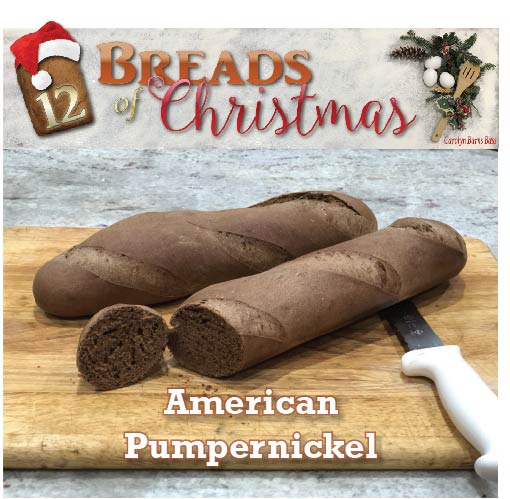
Ingredients
1 c warm water
2 tbl unsalted butter; soft, but not melted
2 tbl dark molasses
1/4 c cocoa powder
1/4 c brown sugar
1 1/2 c white bread flour
1 1/2 c rye flour
1 1/2 tsp salt
1 1/2 tsp dry active yeast (not quick acting)
Instructions
- Mix ingredients in the order listed, either in a bread machine, stand mixer, or a large baking bowl. Knead dough for about 10 minutes. Dough will be glossy, slightly sticky and elastic.
- … Alternate method is to dissolve the yeast in warm water until frothy, then add to dry ingredients.
- Let dough rest in a lightly greased bowl, covered loosely with a light cloth, for about 60 minutes, or until the dough roughly doubles in size.
- Remove dough from mixing bowl and place on counter. (I don’t dust the counter with flour, as this dough doesn’t stick and is easily shaped.) Wet fingers will help dough from sticking to your fingers as you work. Divide the dough into two even lumps. Roll each lump into a log, about 12 inches long, 2 inches in diameter. Dough can be resistant, so roll one lump about 6 inches long, then let it rest while you roll the other lump. Do this back and forth until you’ve reached the correct size.
- Lay rolled dough onto parchment paper, parallel, about 6 inches away from each other. Cover loosely and let loaves proof for another 60 to 90 minutes. Dough will nearly double in girth.
- out the other lump. Do this back and forth until you’ve reached the correct size.
- Using a bread lame, a very sharp knife, or a razor blade, slash three long scores diagonally into each loaf to allow expansion of steam from the loaf as it bakes. This will help avoid cracking of the crust.
- Bake for 30 to 35 degrees, or until the bread has an internal temperature of 200°F when measured with an instant read thermometer.
- This bread is best served warm. To reheat loaves before serving, wrap in foil and place into 350°F for 10 to 15 minutes.
You can tell by the title that this recipe isn’t that type of pumpernickel. A genuine, German pumpernickel bread takes several days to make and requires ingredients that are not easily acquired. If you’re interested in learning more about traditional German pumpernickel, read about it on these terrific food blogs, 196 Flavors, or Ginger and Bread. One day I may hunt down all of these ingredients and make a few loaves for myself, but for now, I’m happy with this American version of pumpernickel.
Traditional pumpernickel gets its distinctive dark color from whole grain rye, along with its three-day preparation process. What Americans commonly call pumpernickel gets its dark color from, get ready… cocoa powder. A traditional pumpernickel calls for only rye flour, while my recipe incorporates white bread flour. Where German pumpernickel is dense and chewy, American pumpernickel is soft and sweet. These two breads are as dissimilar as they can be, but the name pumpernickel sticks to each.
If you’ve enjoyed the bread at either Cheesecake Factory or Outback Steakhouse, you’ll find a comforting similarity with this bread. It’s delicious topped with cream cheese, butter, or simply bare and lightly toasted.


 Save Recipe
Save Recipe